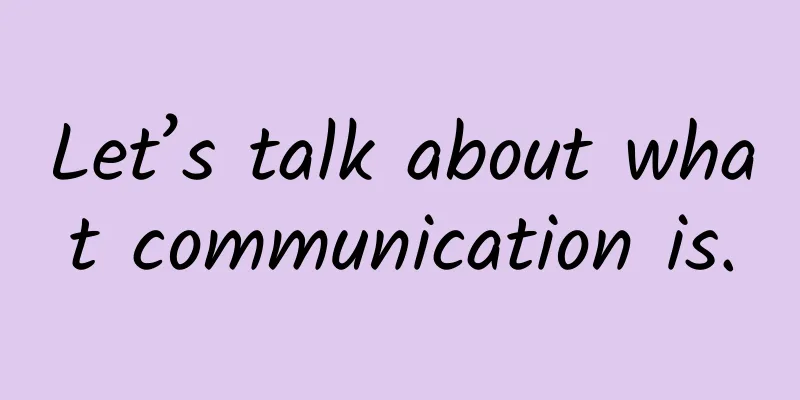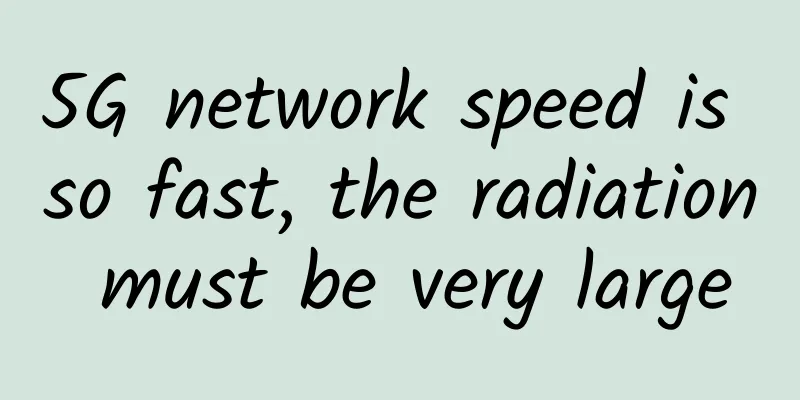Let’s talk about what communication is.

|
For many people, communication is a very general concept. Literally speaking, communication is the communication of information - I send information to you, and you send information to me, this is communication. To be more precise, we can define it as follows: the exchange and transmission of information between people, or between people and nature, through certain behaviors or media is called communication. Yes, communication is a power of all things in the world, an act. Living things and non-living things can initiate this act. This action is a necessary way for every person or thing to integrate into the world. In other words, through the exchange of information, TA can express its own "sense of existence" and "value". The evolution of communicationsThroughout the long history of mankind, most communication scenarios are people-centered. From the moment humans were born, communication has been a basic need for survival. Newborn babies cry to convey hunger information to their mothers, asking for breast milk and love. Tribal members participating in hunting call for support and assistance from their companions through roars. All of this falls under the category of communication. As human organizational forms continue to expand, the role of communication becomes increasingly important. The alliances between countries and the care and concern between relatives are inseparable from communication. The means of communication have also gradually developed from the short-distance methods of "face-to-face conversation and hand gestures" to various long-distance methods such as "beacon fires, flag signals, drums, and gongs". These communication methods are mainly realized through vision or hearing. This requires that the two parties in communication can see or hear each other. The constraints of objective conditions limit the scope of communication. However, if post stations or carrier pigeons are used, although the problems of range and distance can be solved to a certain extent, it brings about the problem of timeliness and delivery cannot be done in a short time. It is difficult to achieve both communication speed and communication distance In the 19th century, the birth and maturity of electromagnetic theory completely changed the development and direction of human communication technology. Based on electromagnetic theory, Morse invented Morse code and wired telegraph, Bell invented the telephone, and Marconi invented the wireless telegraph, thus ushering in the modern communication era for mankind. In this era, the distance limit of communication is constantly being broken. At the same time, the delay of long-distance communication is also constantly decreasing. "Double improvement" in communication speed and distance Communication is closely serving information. The increase in the value of information has led to an increase in the value of communication. With the emergence of globalization and refined division of labor, human society has entered a new stage. The value of information has begun to increase exponentially, and the importance of communication has been raised to an increasingly high level. Today, after more than a hundred years of development, driven by the value of information, communications have evolved from a simple means to a complex discipline. And complex disciplines have incubated huge industries. At this moment, tens of millions of people around the world are engaged in this industry and make a living from it. Every year, millions of young people are injected into this industry as fresh blood. Driven by technology and business, the form, object and efficiency of communication have undergone tremendous changes. Our communication capabilities have made great strides, bringing us into the information age. As you and I have seen, in the information age, people's demand and dependence on communication have become stronger than ever before. Modern communication tools such as mobile phones, as a link for everyone to maintain social connections, have become an indispensable necessity. Not only individuals, but also the entire society is built on the reliance on information and communication technology. The level of advancement of communication technology has become one of the important indicators of a country's comprehensive strength. At present, we are moving from an information society to a digital and intelligent society. The value of information is still being further amplified, and the value of communications will also usher in a second leap. Communications and DigitalizationHuman survival and development are inseparable from the progress of productivity. Competition between nations and games between countries are all centered around productivity. Whoever has stronger productivity will have a higher voice and even the right to survive. In the information age, data is the most valuable resource and computing power is the most important competitive advantage. The key directions of the Fourth Industrial Revolution are: artificial intelligence based on data and computing power, unmanned control, virtual reality, quantum information and other technologies, as well as clean energy and life science technologies. In other words, we are about to enter the advanced stage of the information age - the digital and intelligent age. The degree of digitalization of a country and society largely determines the level of productivity. Therefore, countries around the world, including my country, are striving to promote digital and intelligent transformation. If you want to promote digital transformation, you cannot do without the support of digital technology. The essence of digital technology is information and communication technology, which is now commonly referred to as ICT. ICT technology consists of information technology and communication technology. Information technology is now more popularly called computing power. Communication technology is called connectivity. Digital transformation depends on both non-technical factors (processes, systems, talents) and technical factors. Technical factors are divided into industry technology (such as OT technology in industrial manufacturing), IT technology and communication technology. Information and communication technology serves industry and is now often referred to as mining the value of data. The process of mining data value is further divided into four links: generating data, transmitting data, storing data, and calculating data. The role of communication technology is mainly concentrated in the link of data transmission. We can see that communication is a relatively small but indispensable part of the entire process of data value mining. Without it, data value mining cannot be completed. At present, the value of communications has gradually penetrated from the consumer sector to all industries and from the C-end to the B-end. From serving games, watching dramas, shopping, food, clothing, housing and transportation, it has turned to industrial manufacturing, logistics and transportation, medical education, tourism and culture and other industries. The Internet has evolved from a simple "consumer Internet" to a complete "consumer Internet + industry Internet". Communications has a broader space for development. From a technical perspective, it is true that the room for improving communication capabilities is getting smaller and smaller. From an application perspective, however, the application scenarios of communication are becoming more and more numerous. Perhaps one day, the explosion of application scenarios will stimulate the growth of demand, thereby driving the explosion of the supply side. Stimulated by demand, communication technology experts have the motivation to develop more advanced communication technologies, thus bringing our world into a new stage of communication technology. This is the current situation facing communications. Classification of communication systemsNext, let’s take a closer look at how to build a knowledge system for communication technology. As Xiaozaojun mentioned earlier, every year many young people apply for communications majors and join the communications industry. In recent years, due to the popularity of concepts such as 5G, many investors with non-professional backgrounds have also started to conduct research and analysis on communications technology trends. For people with no basic knowledge, the first time they face communication, they are in a very confused state - it is a huge concept, and it feels like they know everything about communication, but they are like a blind man groping in the dark, and have no idea what it is. 2G/3G/4G/5G/WI-FI/LORA/NB-IOT/Bluetooth/NFC/ZIGBEE... We have heard of countless communication technologies. What is the relationship between them? In fact, if you want to get started with communications, the first step is to understand the interrelationships between communication technologies and establish a complete communication technology knowledge system. There are many ways to classify communications. Some are based on technical characteristics (long distance/short distance, high speed/low speed, duplex/simplex), some are based on the scope of use, and some are distinguished by the owner of the network. Here, I tend to distinguish them based on the objects of use. From a macro perspective, the communication network of the entire human world is divided into public network communication, private network communication and ISM frequency band communication. Public network communication is a communication network provided by operators for every consumer user, including individual users, home users or ordinary corporate users. Its service forms can include cellular mobile communication, fiber optic broadband, cable TV, etc. Private network communication is a communication network used by special government departments or corporate users. It can be built and provided by operators, or built and maintained by government and corporate users themselves. Rail transit, civil aviation, shipping, public security, fire protection, electricity, etc. are all private networks. It should be noted that military network communication is a special type of private network communication. The last one is ISM band communication. ISM stands for Industrial, Scientific and Medical. To facilitate the work of industrial, scientific and medical institutions, countries have allocated free frequency bands, allowing them to use them freely under limited transmission power. Therefore, the ISM band is often also called the unlicensed band. Our Wi-Fi, as well as short-distance communication technologies such as Bluetooth, all belong to the ISM band communication. Its signal transmission power is low and the transmission distance is short, which will not affect the public or private network communication. However, since frequency band resources are scarce, competition is fierce. Once the number of networks increases, congestion will easily occur, causing mutual interference and the speed will decrease accordingly. It is worth mentioning that the distinction based on the object of use is essentially the distinction based on the frequency band used. Different frequency bands are used for different purposes and have different objects of use. From a technical perspective, we now have many communication technologies. These technologies, according to their own characteristics, are used in different scenarios and for different users. Some of them can only be used in the public network, while others can be used in both the public network and private network. Different network technologies have their own network architectures. Public network communication technologies and services such as 4G/5G and fiber-optic broadband have extremely complex network architectures because of their large user scale. Taking 4G/5G cellular mobile communication technology as an example, it is divided into three parts: wireless access network, bearer network and wireless core network. Each part has its own subdivision components, some of which focus on communication channels, and some focus on data routing and exchange. The technical system is extremely complex. In contrast, short-distance communication technologies such as Wi-Fi and Bluetooth have a simple architecture because of their short communication distance. Technologies such as NFC and wireless intercom are even point-to-point communication technologies. The focus of research on these technologies is not on network architecture, but on communication channels. In particular, wireless communication technology and the working principle of the wireless air interface are the key research directions. The purpose of all communication technologies is to transmit data. In terms of the specific forms of services, they can be divided into voice communication (telephone), text communication (text messages), and multimedia communication (pictures, audio, and video). In the past, when modern communications began, the telephone network was built around the telephone service, also known as circuit switching. Circuit switching has evolved from the earliest step-by-step switches and crossbar switches to the program-controlled switches in the 1970s (which everyone should be familiar with). To put it bluntly, program-controlled switching is still a circuit switch that is mainly used for voice services. The bearer mode is also mainly TDM circuits (you can think of it as cables), which cannot meet the needs of packet switching services well. After the 1980s, with the vigorous development of computer networks and multimedia services, data packets can carry all information including voice, so the communication network as a whole has also transformed into a data communication era dominated by data packet transmission. The transmission of data messages is also called "packet switching service", so the data switching network is also called a packet switching network. TCP/IP technology based on packet switching networks is the cornerstone of modern human communication networks. The so-called wireless communication and wired communication are just different in the underlying media. The upper layer still mainly carries data messages. |
<<: 5G and emerging technologies drive data center growth in India
>>: Learn RTMP and RTSP streaming protocols in seconds
Recommend
DogYun newly launched Korean independent server, E5/SSD+NVMe 300 yuan/month after discount, automatic listing
DogYun (Chinese name: 狗云) has launched a new batc...
Are you ready for 5G? Five new applications you'll see
Earlier this year, an article wrote: 5G will tran...
Introduce the commonly used encoders and decoders in Netty
[[359182]] The previous article introduced Netty ...
Xi'an Yimatong previously reported: It took two days and two nights to optimize a 1M image to 100kb
Xi'an's health code crashed twice in a ro...
Inventory: 11 foreign SASE vendors
SASE (Secure Access Service Edge) is a networking...
Application of 5G in the Public Sector of Future Smart Cities
The integration of 5G technology is expected to s...
ExtraVM: $2.75/month-1GB/15G NVMe/1Gbps unlimited traffic/Los Angeles data center
ExtraVM is offering a promotion for VPS hosts in ...
5G commercial use is still not good enough in the past two years? Is 5G really useless?
[[420040]] Before we knew it, 5G has been officia...
DogYun National Day promotion: 30% off on Elastic Cloud/20% off on Classic Cloud, 10 yuan free for every 100 yuan top-up, 100 yuan off for dedicated servers
The whole country celebrates together, and China ...
Samsung, Qualcomm, Huawei, and Nokia, who are the world's top players in 5G technology?
Who are the top players in 5G? A report from rese...
Wu Jingtao returns to F5 as new CTO to explain F5's future direction
[51CTO.com original article] Wu Jingtao is the ki...
The difference between NFV automation and NFV orchestration
NFV automation and NFV orchestration have overlap...
Network Programming - Another Look at TCP's Four Waves
[[270759]] Preface Four waves The four-wave proce...









